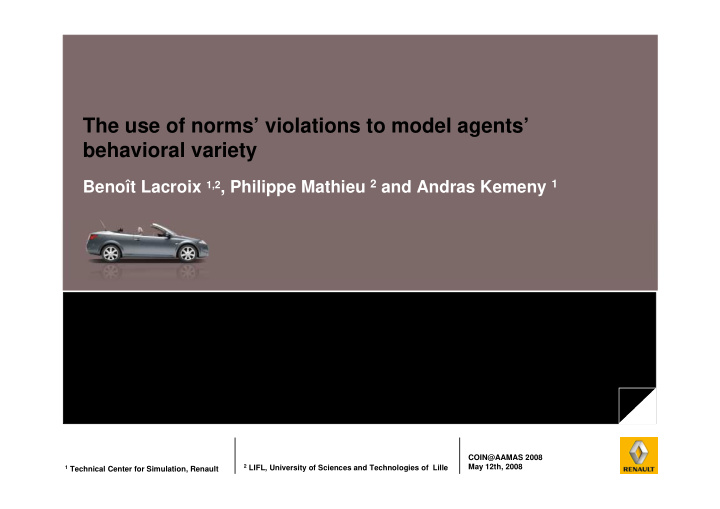



The use of norms’ violations to model agents’ behavioral variety Benoît Lacroix 1,2 , Philippe Mathieu 2 and Andras Kemeny 1 COIN@AAMAS 2008 2 LIFL, University of Sciences and Technologies of Lille 1 Technical Center for Simulation, Renault May 12th, 2008
Motivation � LIFL / Renault collaboration � Traffic simulation in driving simulators � Needs � Improve the behavioral realism of autonomous vehicles � Obtain consistent and various behaviors � Idea � Driving psychologists classify drivers depending on their behavior (Saad, 1992) � The Highway Code is a set of norms � Drivers do not strictly follow the Highway Code = model behavioral variety as violations of the norms 2 Benoît Lacroix COIN@AAMAS 2008 May 12th, 2008
Session context � Determine fulfillment and violations of expectations without recourse to future information � Not possible to see future on real-time applications with human in the loop � Strong interest in simulation to analyse how humans behave and adapt agents’ behavior � Protect agents from potentially harmful interactions � Consistency with characteristics and capabilities of the agents � Manage the consistency of the agent itself 3 Benoît Lacroix COIN@AAMAS 2008 May 12th, 2008
Plan � General context and proposed approach � Related work � Institutional environment � Application to traffic simulation � Conclusion and future work 4 Benoît Lacroix COIN@AAMAS 2008 May 12th, 2008
General context and approach � General context: simulation of spatially situated agents � Microscopic simulations � Behaviors’ emergence through interactions � A need of variety and consistency for realism � Our approach � Use norms to generate the characteristics of the agents � No regulation of their behavior � Based on norms’ definitions and norms’ violations 5 Benoît Lacroix COIN@AAMAS 2008 May 12th, 2008
Related work � Institutions and norms (Noriega, 1997; Esteva et al., 2001) � Regulation and management of agents’ social interactions � Authority and control instances � Improvement of traffic control strategies (Bou et al., 2007) � Autonomic capabilities of institution � Application to traffic � Non-normative behaviors in traffic simulation (Doniec et al., 2006) � Introduce formal rules of the road � Agents allowed to break them 6 Benoît Lacroix COIN@AAMAS 2008 May 12th, 2008
Institutional environment � Replication of properties allows specifying elements � No control instance (handled by the execution model) 7 Benoît Lacroix COIN@AAMAS 2008 May 12th, 2008
Behavior variety � Through norms’ definitions � While instantiating behaviors � By violating the norm � Parameters generation outside the definition domains � Consistency no more guarantied � Able to quantify the deviation � Choice between allowing or not to violate norms � Conflicting norms � Norms does not rule the whole environment � Handled by the underlying execution model 8 Benoît Lacroix COIN@AAMAS 2008 May 12th, 2008
Application: driving simulators � Ergonomics, embedded systems, design, headlights… � Agents’ decision model: perception – decision (finite state automata) – action (vehicle dynamic model) 9 Benoît Lacroix COIN@AAMAS 2008 May 12th, 2008
Traffic simulation � Drivers behavior � Individual differences (Dewar, 2002) � Psychological factors � Formal rules, informal rules, design of the road and other drivers behavior (Björklung, 2005) � Road system � Highway code: set of norms � Country, city, local rules 10 Benoît Lacroix COIN@AAMAS 2008 May 12th, 2008
Current implementation � Choices � Norms does not manage the whole traffic logic � Uses the existing traffic model (finite state automata) � Norms based on driver parameters � Current norms � Define normal, aggressive, cautious and elderly drivers � Easily extensible by driving psychologists 11 Benoît Lacroix COIN@AAMAS 2008 May 12th, 2008
Example 12 Benoît Lacroix COIN@AAMAS 2008 May 12th, 2008
13 Benoît Lacroix COIN@AAMAS 2008 May 12th, 2008
14 Benoît Lacroix COIN@AAMAS 2008 May 12th, 2008
Conclusion and future work � Conclusion � Able to guaranty the consistency of the parameters � Realistic behaviors without hard-coded scenarisation � Future work � Macroscopic validation with real data � Introduction of atomic norms defining behaviors (speeding, relative to environment (city, highway)…) � Study the effect of norms’ violation on the global system, as well as norms proportion influence 15 Benoît Lacroix COIN@AAMAS 2008 May 12th, 2008
Thank you for your attention Contact: benoit.lacroix@renault.com 16 Benoît Lacroix COIN@AAMAS 2008 May 12th, 2008
Questions? � As an agent is just a piece of software, how is it possible for it to violate a norm? It only does what I defined ;-) � Isn’t « outside of norms » also a norm? Norms are defined behaviors, you have a name for them or not, but you are always in one of them! � How to qualify norms violations? 17 Benoît Lacroix COIN@AAMAS 2008 May 12th, 2008
Recommend
More recommend